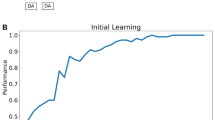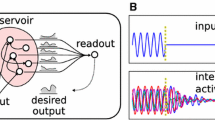Abstract
Based on a connectionist model of cortex-basal ganglia-thalamus loop recently proposed by authors, a simple connectionist model realizing the Stroop effect is established. The connectionist model of cortex-basal ganglia-thalamus loop is a nonlinear dynamical system and the model is not only capable of revealing the action selection property of basal ganglia but also is capable of modelling the effect of dopamine on action selection. While the interpretation of action selection function is based on solutions of nonlinear dynamical system, the effect of dopamine is modelled by a parameter. The effect of dopamine in inhibiting the habitual behaviour corresponding to word reading in Stroop test and letting the novel one occur corresponding to colour naming is investigated using the model established in this work.
Preview
Unable to display preview. Download preview PDF.
Similar content being viewed by others
References
Churchland, P.S.: Neurophilosophy. Toward a Unified Science of the Mind-Brain. The MIT Press, Cambridge (1988)
Cohen, D., Servan-Schreiber, D.: Context, Cortex, and Dopamine: a Connectionist Approach to Behaviour and Biology in Schizophrenia. Psychological Review 99, 45–77 (1992)
Doya, K.: Reinforcement Learning in Continuous Time and Space. Neural Computation 12, 219–245 (2000)
Gurney, K., Prescott, T.J., Redgrave, P.: A Computational Model of Action Selection in the Basal Ganglia. I. A New Functional Anatomy. Biological Cybernetics 84, 401–410 (2001)
Taylor, N.R., Taylor, J.G.: Hard-wired Models of Working Memory and Temporal Sequence Storage and Generation. Neural Networks 13, 201–224 (2000)
Ashby, F.G., Casale, M.B.: A Model of Dopamine Modulated Cortical Activation. Nral Networks 16, 973–984 (2003)
Karabacak, O., Sengor, N.S.: A Dynamical Model of a Cognitive Function: Action Selection. In: 16th IFAC congress (2005)
Alexander, G.E., Crutcher, M.D., DeLong, M.R.: Basal Ganglia-Thalamocortical Circuits: Parallel Substrates for Motor, Oculomotor, “Prefrontal” and “Limbic” Functions. Progress in Brain Research 85, 119–146 (1990)
Sagvolden, T., Johansen, E.B., Aase, H., Russel, V.A.: A Dynamic Developmental Theory of Attention-Deficit/Hyperactivity Disorder (ADHD) Predominantly Hyperactive/ Impulsive and Combined Subtypes. Behavioural and Brain Sciences 28, 397–468 (2005)
Cohen, J.D., Braver, T.S., Brown, J.W.: Computational Perspectives on Dopamine Function in Prefrontal Cortex. Current Opinion in Neurobiology 12, 223–229 (2002)
Kaplan, G.B., Sengor, N.S., Gurvit, H., Guzelis, C.: Modelling Stroop Effect by a Connectionist Model. In: Proceedings of ICANN/ICONIP, pp. 457–460 (2003)
Horvitz, J.C.: Mesolimbocortical and Nigrostriatal Dopamine Responses to Salient Non-Reward Events. Neuroscience 96, 651–656 (2000)
Servan-Schreiber, D., Bruno, R.M., Carter, C.S., Cohen, D.: Dopamine and the Mechanisms of Cognition: Part1. A Neural Network Model Predicting Dopamine Effects on Selective Attention. Biological Psychiatry 43, 713–722 (1998)
Djurfeldt, M., Ekeberg, Ö., Graybiel, A.M.: Cortex-basal ganglia interaction and attractor states. Neurocomputing 38-40, 73–579 (2001)
Author information
Authors and Affiliations
Editor information
Editors and Affiliations
Rights and permissions
Copyright information
© 2006 Springer-Verlag Berlin Heidelberg
About this paper
Cite this paper
Karabacak, O., Sengor, N.S. (2006). A Computational Model for the Effect of Dopamine on Action Selection During Stroop Test. In: Kollias, S.D., Stafylopatis, A., Duch, W., Oja, E. (eds) Artificial Neural Networks – ICANN 2006. ICANN 2006. Lecture Notes in Computer Science, vol 4131. Springer, Berlin, Heidelberg. https://doi.org/10.1007/11840817_51
Download citation
DOI: https://doi.org/10.1007/11840817_51
Publisher Name: Springer, Berlin, Heidelberg
Print ISBN: 978-3-540-38625-4
Online ISBN: 978-3-540-38627-8
eBook Packages: Computer ScienceComputer Science (R0)




